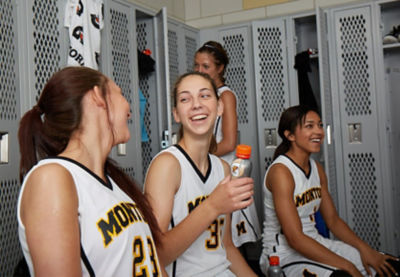Basketball 101: Know the Court
To know the game, you need to understand the court. Pro Tips is here to guide you across the hardwood.

Ever wonder just how much space basketball players have when they’re out on the court? How big is the hoop they need to shoot the ball through? Where exactly is the three-point line? Pro Tips has the answers to help you get acquainted with the size and scope of a basketball court.
There are also a few rules you’ll need to know while you’re cheering on your favorite players from the stands.
OVERALL COURT SIZE
Professional courts are typically 94 feet long by 50 feet wide. For high school regulation games, courts are 84 feet long by 50 feet wide. Keep in mind that an older gym could be smaller than regulation size.

THE FOUL LINE
For all courts, the foul line is 15 feet from the front of the backboard and two inches wide.
WHAT'S THE RULE?
Players are given “free throws,” or shots from the foul line, against the defense when they are fouled in the act of shooting. During the free throw, the shooter may not step over the foul line but can use the space behind them. When the opposing team has gone over their foul limit for a given half, the shooter goes to the foul line for a “one-and-one” shot. This means that shooter will attempt one guaranteed basket. The chance for a second shot from the foul line depends on if the shooter converts the first attempt.
When lining up for a foul shot, there will be six players outside of the key, but in between the hashmarks. These are small lines that separate the spaces players can stand in. When inside the hashmarks, players cannot put their foot or arms over into another player’s area.
THE KEY
Sometimes called “the lane,” the key is 12 feet wide. Professionally, the lane is 16 feet wide. On regulation courts, the backboard extends 4 feet from the baseline into the key. To complete the key, a semicircle with a 6-foot radius extends from the foul line.
WHAT'S THE RULE?
A common call made by officials, especially against power forwards and centers, is a three-second violation. This violation occurs when a player on offense spends three or more seconds in the lane at one time. Keep moving around the court to avoid getting whistled for this violation.
THE THREE-POINT LINE
In professional basketball, the distance from the center of the basket to the three-point line is 22 feet. However, there are some changes at the collegiate and high school level:
- College courts measure the distance at 20 feet, 9 inches long.
- High school courts use a distance of 19 feet, 9 inches from the hoop.
WHAT'S THE RULE?
As the name implies, a player only receives three points if they are completely behind the three-point line when they attempt (and make) a shot. If any portion of a player’s shoe is touching the line as they jump to shoot, they’ll only be awarded two points if the basket is good.
BONUS PRO TIP: The lines that indicate the three-point line, the key and the length and width of the court can vary in color. Your home court might have white lines on the court. But be aware of changes in color on other courts.
THE RIM
The distance from the ground to the top of the rim is 10 feet for all levels of play. All basketball rims are 18 inches in diameter. The rim is typically orange in color for visibility and a net usually hangs off the rim. The net is white and made of nylon, which helps provide durability.
THE BACKBOARD
Regulation backboards are 6 feet wide and 3.5 feet tall. The inner square on the backboard is 24 inches wide by 18 inches tall.
WHAT'S THE RULE?
Neither offensive nor defensive players can alter the direction of the ball while it’s on or above the rim. Violations include grabbing or shaking the rim, backboard or net.
Know where you’re at on the court while keeping your attention on the action happening around you. Being aware of your surroundings can help you understand the game better.
Getting ready for a busy basketball tournament schedule? Pro Tips has your tournament checklist with some slam dunks on what to bring and what to leave at home.








